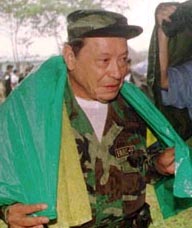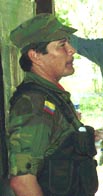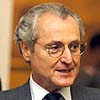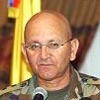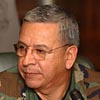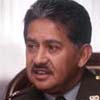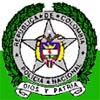 |
| Home | | |
Analyses | | |
Aid | | |
| |
| |
News | | |
| |
| |
| |
|
Last
Updated:12/5/04
|
| Information
about the combatants
There are three sets of actors in Colombia's longstanding conflict: leftist guerrilla groups, right-wing paramilitary groups, and government security forces. While guerrillas and paramilitaries do not appear to have a significant support base, most are well-funded and control significant amounts of territory. All combatants commit serious abuses of human rights and international humanitarian law.
What today is the hemisphere's largest guerrilla group began after a U.S.-supported attack on a Communist Party-inspired peasant cooperative in southern Tolima department calling itself the "independent republic of Marquetalia." According to the guerrilla group's version of events, the May 1964 raid pitted 16,000 military personnel against a community of 1,000, of which forty-eight were armed. Survivors of the Marquetalia raid founded the FARC shortly afterward, led by Manuel Marulanda, a peasant guerrilla who had fought since 1948 in a period of partisan bloodletting known as La Violencia. Still headed by the septuagenarian Marulanda, the FARC now has about 18,000 members in almost 70 fronts, organized in regional "blocs," plus mobile columns and urban militias. The group controls or operates freely in 40 to 60 percent of country, usually sparsely populated areas, rural zones, jungles and plains, and rarely in significant population centers. Its principal strongholds are east and south of the Andes. While it received limited assistance from the Soviet bloc during the Cold War, today the FARC finances itself through kidnapping for ransom, extortion, and involvement in Colombia's drug trade. Together with the ELN (described below), the FARC is responsible for the majority of kidnappings committed in Colombia. Over fifty of those in FARC custody are officials (Colombian legislators, governors, ex-presidential candidate Íngrid Betancourt, and three U.S. citizens working for a Defense Department contractor) the group has held for years, insisting on exchanging them for FARC prisoners in Colombian jails. The FARC and ELN are responsible for about 20 percent of killings associated with Colombia's conflict, many of them civilian non-combatants. The FARC carries out occasional massacres, and has claimed many innocent lives through indiscriminate use of inaccurate gas-cylinder bombs. The FARC regularly recruits minors, at times by force. Much of Colombia's coca is grown in FARC-controlled areas, and the guerrillas' link to the drug trade is the source of much controversy. While this link is chiefly "taxation" of coca-growers in the areas it controls, the group has some involvement in drug production and transit, though the paramilitaries likely control a far greater share of these latter phases of the narcotrafficking chain. The Colombian Armed Forces estimate that the FARC gets about half its income from involvement in narcotics trafficking, an amount that is probably between $200 million and $400 million per year (estimates range from $100 million to $1 billion). Aided in part by this income source, the FARC grew rapidly during the 1990s, and dealt the Colombian military several humiliating defeats in 1996-1998. It has since lost some momentum, losing key battles to the army and some territory to paramilitaries. The FARC was involved in unsuccesful attempts to negotiate peace in 1984-87, 1991, 1992 and 1998-2002. During the first peace process -- which even brought a cease-fire -- the FARC set up a political party, the Patriotic Union, which the group had hoped to use as a vehicle for an eventual entry into non-violent political participation. Between the Patriotic Union's founding in 1985 and the early 1990s, at least 2,000 of the party's congress members, mayors, candidates and activists were killed by paramilitaries, security forces, and drug cartels. The slaughter of the Patriotic Union left the FARC's military structure intact, but left the group with few articulate political spokespeople.
The ELN was founded in 1964 by a group of Colombian students who underwent training in Cuba. The group launched its first military operations in Colombia's north-central Magdalena Medio region the following year. Attempting to follow the Cuban model of rural rebellion, the ELN grew slowly but attracted many radical students and priests. Among the priests were Camilo Torres, a firebrand who died during his first combat in 1966, and two Spaniards, Domingo Laín and Manuel Pérez. Pérez served as the group's maximum leader from the 1970s until his death of natural causes in 1998. Today, ELN membership is estimated at about 3,500 members, down from a late-1990s high of about 5,000. The group, which does not profit significantly from the drug trade, has lost ground to paramilitary groups. The ELN relies more heavily on kidnapping and extortion to support itself. It frequently targets Colombia's oil sector, which it regards as dominated by foreign interests. Bombings of pipelines and energy infrastructure (such as power lines) are frequent. The group has also carried out several high-profile mass kidnappings since 1999. The ELN was involved in brief peace talks with the government in 1991 and 1992, participating together with the FARC in a now-defunct structure called the "Simón Bolívar Guerrilla Coordination." The group held sporadic talks with the Colombian government between 1998 and 2002, and has maintained contacts with the Uribe government via the Mexican government since 2003. For years, the ELN has declared its intention to negotiate its peace agenda through a several-month "convention" with Colombia's civil-society and popular groups.
Colombia has at least three other, far smaller insurgent groups. The Popular Liberation Army (EPL) is a remnant that refused to go along when the original EPL, a Maoist-inspired group, negotiated a peace accord with the government in 1991. Perhaps a few dozen members remain; the group's leader, Francisco Caraballo, is in prison. The ERG (Guevarist Revolutionary Army) and ERP (Popular Revolutionary Army), tiny groups that are essentially satellites of the FARC and ELN, carry out occasional kidnappings and terrorist attacks.
Colombia has a long history of privately-financed peasant self-defense groups, usually suffused with their wealthy patrons' right-wing beliefs. These groups' numbers began to grow rapidly in the 1980s. The growth coincided with the advent of Colombia's drug trade. Newly wealthy drug traffickers laundered their profits by buying up as much as 2.5 million acres of land in northern Colombia during the 1980s. These new landholders put together private armies to deal with the guerrillas who kidnapped and extorted wealthy ranchers in the area. One of the first, and most feared, was a group calling itself "Death to Kidnappers" (Muerte a Secuestradores, or MAS), active in the Magdalena Medio region of north-central Colombia. With funding from drug traffickers and other large landholders, and close and open collaboration with Colombia's armed forces, the paramilitaries gained strength throughout the 1980s. Their tactics -- selective assassinations and forced disappearances, massacres, forced displacement of entire populations -- quickly made them one of the country's main human rights abusers. They also played a strong role in the decimation of the Patriotic Union political party (see FARC section above). The
abuses of groups like MAS caused paramilitaries to be declared
illegal in 1989. Little was done to disband them, though. Human
rights groups have documented widespread post-1989 collaboration
between Colombia's armed forces and paramilitary groups. By 1997, Carlos Castaño had organized the ACCU and several other paramilitary groups throughout the country into a national structure, the United Self-Defense Groups of Colombia (AUC). The group grew rapidly, from perhaps 4,000 members in 1998 to about 18,000 today. The AUC is more of a loose, fluid confederation than a unified structure. The AUC even dissolved briefly in 2002, with Carlos Castaño's decision to resign from the AUC's leadership because "everyone does as he wishes". Divisions within the group over links to the drug trade worsened during the early 2000s, exacerbated by the U.S. Justice Department's requests to extradite AUC leaders for narcotrafficking and the State Department's inclusion of the AUC on its list of international terrorist groups. At the same time, a new wave of individuals with long histories as narcotraffickers has entered the group's top leadership since about 2000. Leaders like Diego Fernando Murillo ("Don Berna"), Víctor Manuel Mejía ("El Mellizo") and Francisco Javier Zuluaga ("Gordolindo") have recently moved from Colombia's drug underworld to command of key paramilitary blocs. After several years of divisions, including increasing incidents of combat between groups (particularly in Magdalena and Casanare), the AUC is now more adequately represented by blocs than by one singular banner. 2004 has seen the murder of several prominent paramilitary leaders at the hands of fellow paramilitaries: Carlos Castaño in April, "Rodrigo 00" of the now-defunct Metro Bloc in June, and Miguel Arroyave of the Centauros Bloc in September. This has been happening against the backdrop of peace talks with the government of Álvaro Uribe, which began in December 2002. The talks, focusing on terms of the paramilitaries' demobilization, are taking place in a small demilitarized zone in Santa Fe de Ralito, a town in Tierralta municipality in southern Córdoba department. The talks face many obstacles, among them the AUC's non-observance of a promised cease-fire; the entry of narcotraffickers into the group's top leadership; the likelihood of amnesty or light sentences for those who committed crimes against humanity; U.S. extradition requests; and the Colombian government's probable inability to secure zones currently under paramilitary control.
The
Northern Bloc - Run by current AUC military leader Salvatore
Mancuso, the Northern Bloc incorporates Fidel and Carlos Castaño's
original ACCU, controlling municipalities in a swath of territory
stretching from the Panamanian to the Venezuelan borders. Mancuso's
deputy in the Caribbean coast is Rodrigo Tovar Pupo, more commonly
known as Jorge 40, whom authorities believe controls much of Colombia's
Caribbean drug routes. Vicente Castaño, Carlos and Fidel's
brother, is a third powerful player - and he is widely believed
to have played a role in Carlos' death. The "Élmer Cárdenas Bloc" - Led by José Alfredo "El Alemán" Berrío, the Elmer Cardenas Bloc was originally part of the ACCU, which through a wave of brutality and massacres gained control of the strategic Urabá region near the Colombian-Panamanian border during the 1990s. Substantial evidence suggests that Berrío and the Élmer Cárdenas Bloc are very strong in drug trafficking. This bloc is one of few not currently participating in peace talks. The Magdalena Medio Bloc - Led by Ramón "El Viejo" Isaza on the west side of the Magdalena river, one of the the most veteran paramilitaries, and Victor Triana "Botalón" Arias on the other side of the river. The Central Bolivar Bloc - Deeply involved in Colombia's drug trade, the BCB rivals (and perhaps exceeds) the Northern Bloc in size and wealth. Led by Iván Roberto "Ernesto Baez" Duque, the BCB controls much of the greater Magdalena Medio region and significant portions of southern Colombia's coca-growing regions.
The "Mineros" Bloc - Though it controls a small area
in northeast Antioquia, the Mineros Bloc is quite wealthy, largely
from narcotrafficking. It is led by Ramiro "Cuco" Vanoy,
wanted by the United States for his participation in the North
Valle drug cartel. The Calima Bloc - Situated in and around Cali and down the Pacific coast to northern Cuaca, and led by Hernán Hernández, this bloc formed in 1999 after the ELN staged a kidnapping in a church in a wealthy Cali neighborhood. Heavily dependent on drug traffickers' support, the bloc is scheduled to demobilize by the end of 2004. The "Avengers of Arauca" Bloc - Commanded, at least on paper, by Pablo Mejia ("El Mellizo"), a Northern Valle Cartel figure wanted by the United States, this bloc operates in an oil producing region that has been a principal destination of U.S. military assistance. The "Libertadores del Sur" Bloc - Operating in the coca-growing zones of Nariño and Putumayo and led by Guillermo Pérez Alzate ("Pablo Sevillano"), a noted narcotrafficker wanted by U.S. authorities. The "Centauros Bloc" - Operating in oil-rich Casanare, Meta, Cundinamarca and Bogotá's slums, this bloc is disintegrating following the murder of its leader, Miguel Arroyave, at the hands of his own men in September 2004. The Centauros have fought a bloody campaign against the Llanos Bloc in Casanare. The
Llanos Bloc - Headed by "Martín Llanos," based
in Casanare and not participating in peace talks, this bloc has
been nearly decimated by repeated attacks from the rest of the
AUC (especially the Centauros Bloc) and the Colombian military.
The most publicly recognized leader of the AUC is Salvatore Mancuso. A former Córdoba rancher, Mancuso is currently the "Maximum Comandante" of the AUC and chief negotiator in Santa Fe de Ralito. Mancuso has been sentenced to 40 years in jail for his participation in the 1997 El Aro Massacre in 1997, and faces eight different arrest orders. All warrants and charges have been suspended, however, during the current peace talks. Zone of Paramilitary presence over time
Though Colombia has avoided most Latin American countries' histories of chronic military coups, its armed forces operate with considerable autonomy and often challenge civilian leaders. Over the years, Colombia's security forces, especially its Army, have suffered from a reputation for corruption, human rights abuse and poor performance on the battlefield. The military has nonetheless maintained very close relations with the United States at least since the early cold war (Colombia even sent a battalion to Korea in 1950). This collaboration has intensified since 1999, when the bulk of US counter-drug aid shifted from the National Police to the Army. Colombia's Defense Ministry, headed by a civilian since the 1991 Constitution was ratified, includes the Army (about 180,000 members), Police (about 150,000), Air Force (about 10,000) and Navy (about 5,000).
Colombian law exempts anyone with a high-school education from serving in combat units. With a large contingent of these "bachilleres" and many soldiers guarding oil installations and infrastructure, perhaps half of the Army -- maybe less -- is available to fight illegal armed groups. The Colombian government has announced its intention to reduce the number of "bachilleres" and add professional volunteer soldiers. The armed forces have improved their battlefield performance since suffering embarrasing defeats at the hands of the FARC in 1996-98. In 2000 and 2001 the Army won decisive battles in Sumapaz, a zone 50 miles south of Bogotá, in Santander department ("Operation Berlín"), and in Vichada and Guanía departments ("Operation Black Cat"). Offensives carried out by the Uribe government have generally been successful. Maintaining control over re-conquered territories, however, remains a challenge, since investment in civilian governance is scarce. Though their share of direct involvement in killings and disappearances has fallen in recent years to a current level of about 5-7 percent, the armed forces nonetheless continue to face serious allegations of indirect human rights abuse through collaboration with paramilitary groups. Except for a few high-profile cases, past abusers continue to enjoy near-complete impunity. [See the reports linked from the human rights section of this site's "Links" page.] |
||||||||||||||||||||||||||||||||||||||
|
|
| Asia | | |
Colombia | | |
| |
Financial Flows | | |
National Security | | |
| Center
for International Policy |
